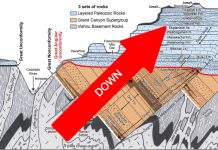

CALGARY, Alberta – A blue ribbon committee of the World Organization of Petroleum Societies (WOOPS) has released its recommendation to the full membership to revamp the classification system for stones. A vote to accept or reject the report will be taken at the next annual convention, whenever the pandemic allows or the executive committee feels like it. The document is rather lengthy and detailed, so a highly condensed and limited version is presented herein.
There are three broad classifications of stones based on origin:
-
- Hail stones are those that fall out of the sky. The Earth, being the center of the universe, has a natural ability to attract objects from the heavens. Meteorites are in this group, also moon stones.
- Brim stones are those with an origin in Hades. They reach the surface primarily through volcanoes, although other conduits are suspected.
- Rhine stones are those with a completely terrestrial origin. This would include sand stones, silt stones and clay stones.
A subset of the three classifications is the tectonic setting of the stones. There are two.
-
- Rolling stones are those that have moved since they were formed.
- Corner stones are those that have not moved since formation or arrival on Earth’s surface.
Going further, there are four classifications based on alchemic properties.
-
- Touch stones are those with the property of transmuting base metals into noble metals.
- Anti-touch stones are those that will not transmute base metals into noble metals.
- Lode stones are those that when floated on a cork in a basin of water align north-south.
- Anti-lode stones are those that do not align north-south but rather east-west.
Special properties of certain stones can also be described. Examples include:
-
- A brown stone is brown.
- A yellow stone is from an American National Park.
- A mile stone extends for 1.6 kilometers.
- A head stone is suitable for carving into a grave stone.
- A soap stone is something like talc or pumice that can be used for hygiene.
- A lime stone may be used to flavor a margarita or add some zip to guacamole.
- A field stone marks the boundaries of an oil and gas reservoir.
- A flag stone appears on the banners of several countries.
- A gall stone is from France.
The final test for a stone is the tone it makes when struck by a rock hammer. An ear for music is necessary for this step.
As you can see, a great many conditions and circumstances can be covered, explaining why the original document is so lengthy. To adequately describe a stone, the describer should list the above elements in reverse order that they are presented. A new stone may be described as F Sharp brown anti-lode rolling rhine stone.
Editor’s Note: This classification scheme was first proposed in the Journal of Irreproducible Results.


















